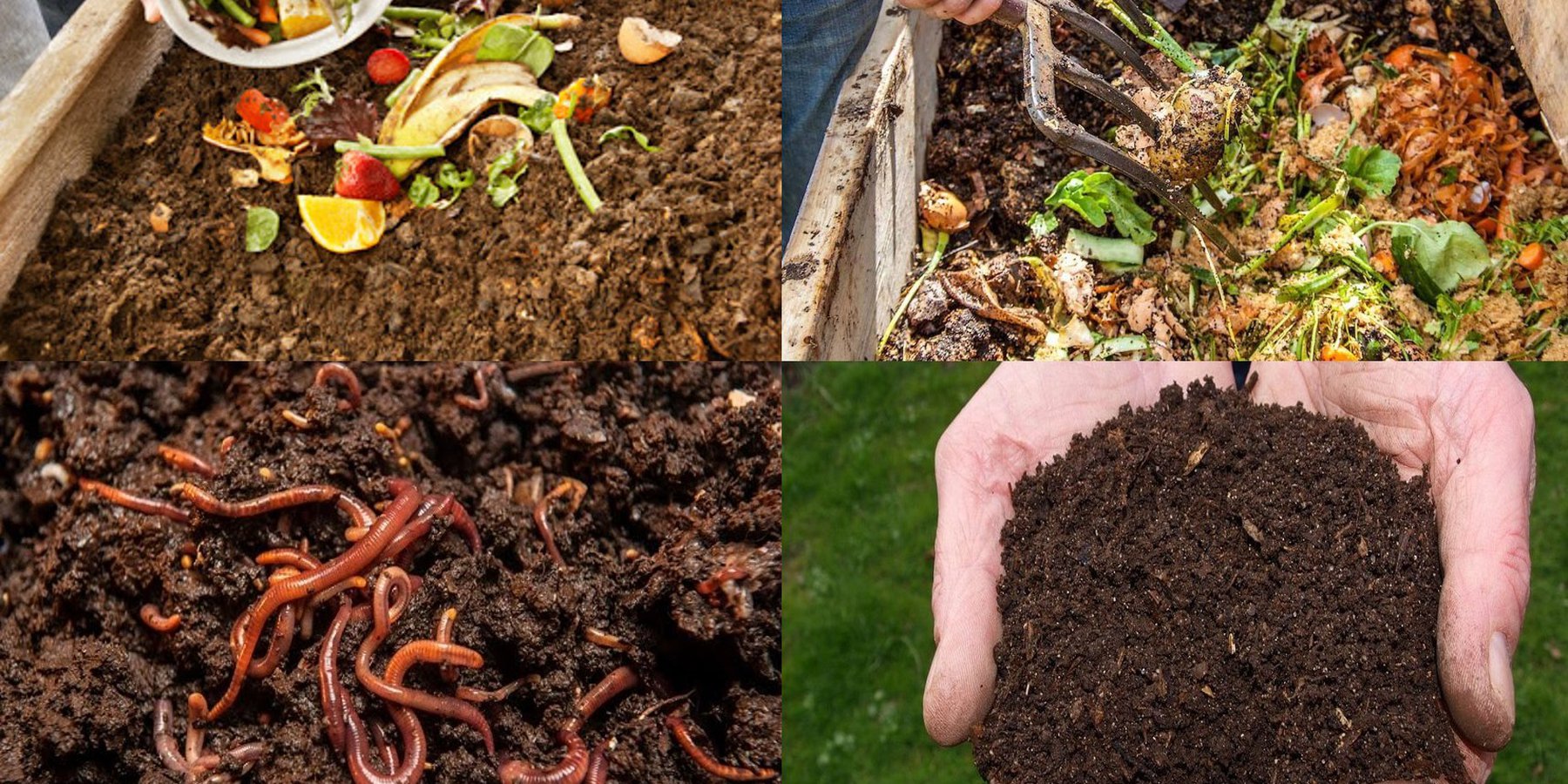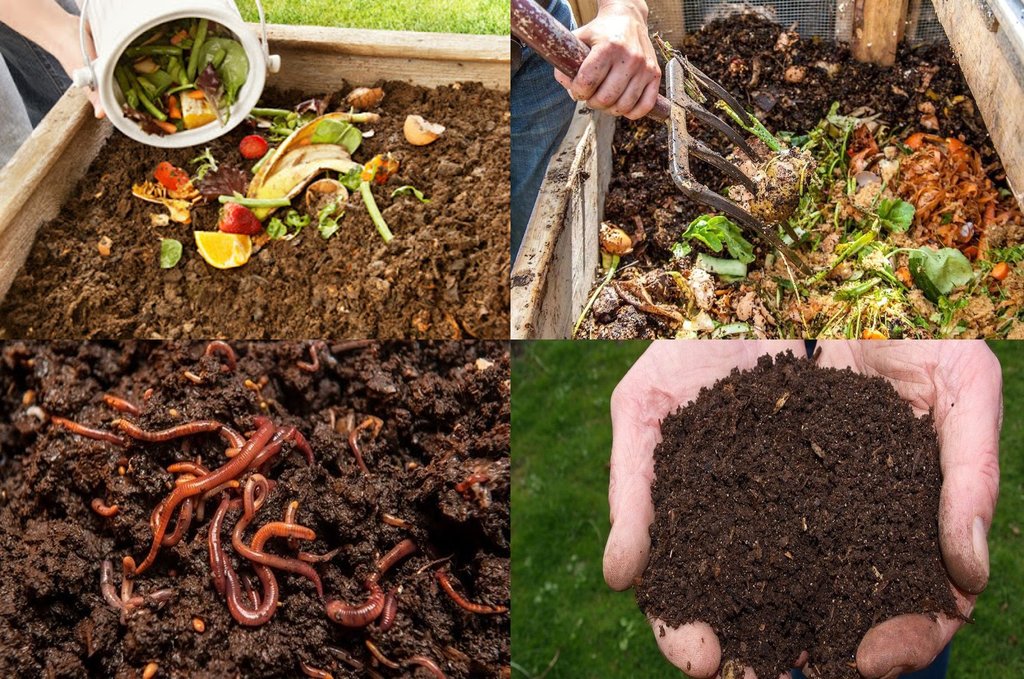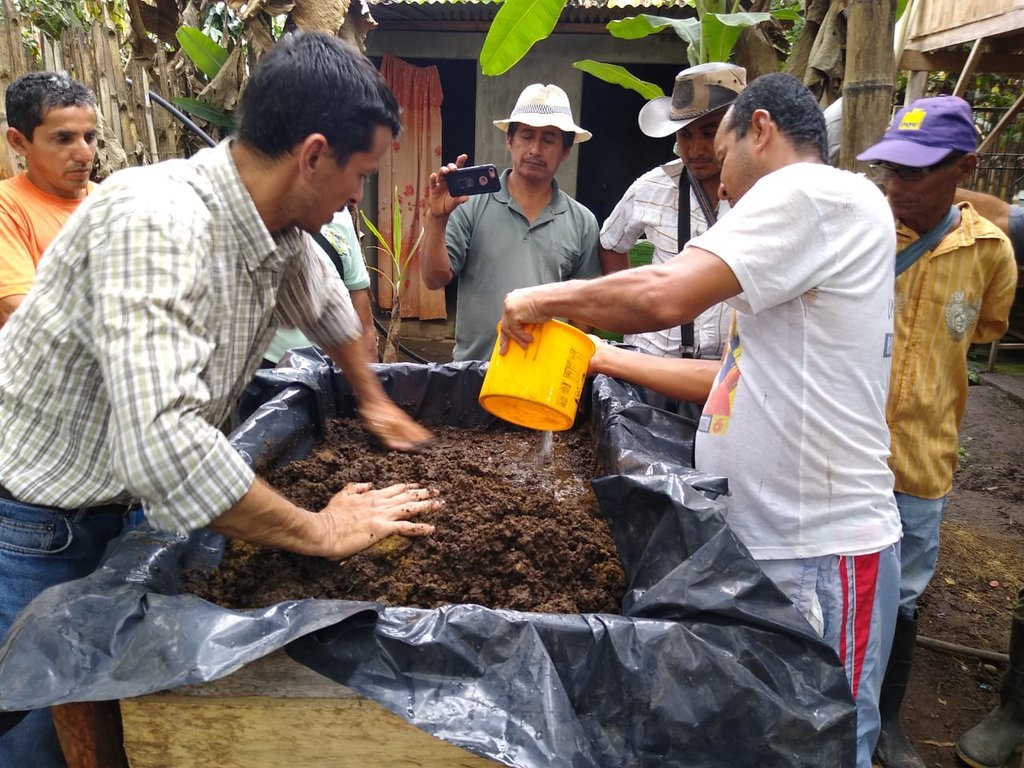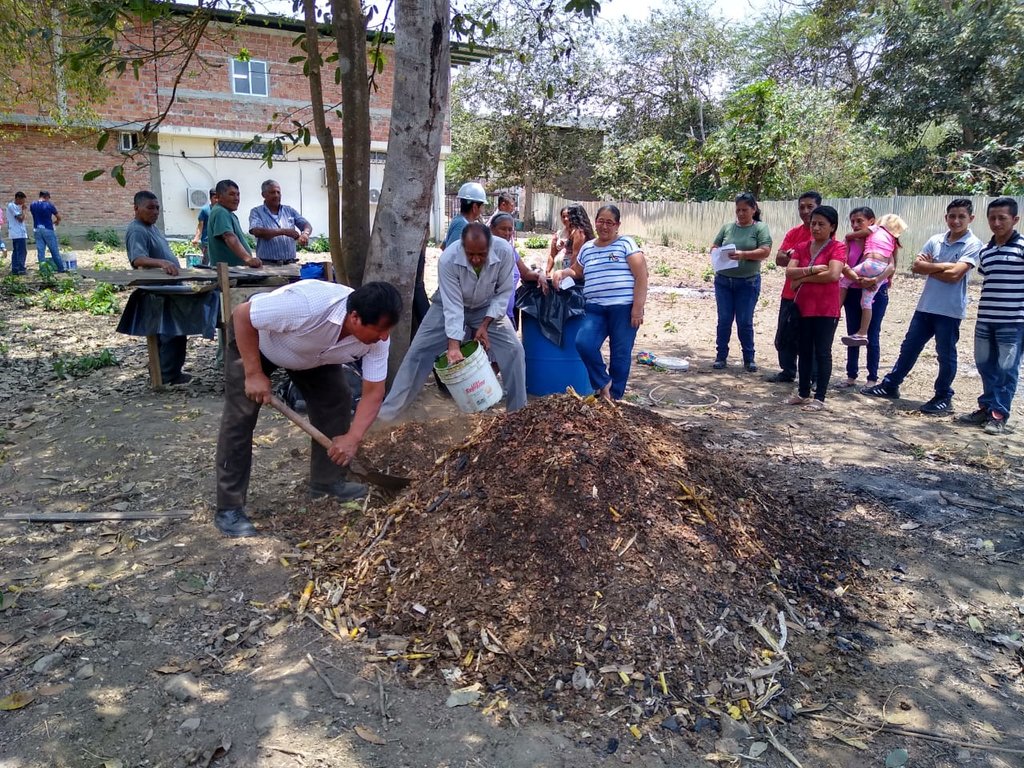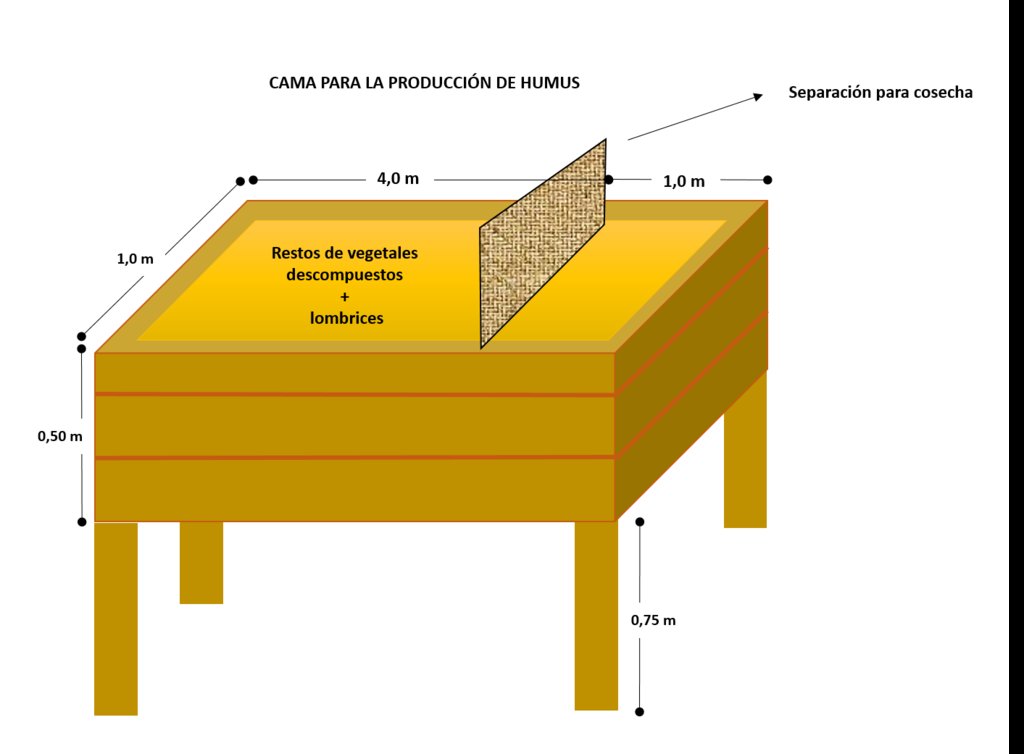Abono orgánico [Ecuador]
- Creation:
- Update:
- Compiler: Pablo Caza
- Editor: Carlos Samaniego
- Reviewers: Giacomo Morelli, Nicole Harari, Johanna Jacobi
Abono orgánico ,abono natural, tierra para sembrado, tierra sana. líquidos natrurales.
technologies_3270 - Ecuador
View sections
Expand all Collapse all1. General information
1.2 Contact details of resource persons and institutions involved in the assessment and documentation of the Technology
Key resource person(s)
SLM specialist:
Ecuador
Name of project which facilitated the documentation/ evaluation of the Technology (if relevant)
Decision Support for Mainstreaming and Scaling out Sustainable Land Management (GEF-FAO / DS-SLM)Name of the institution(s) which facilitated the documentation/ evaluation of the Technology (if relevant)
Ministerio de Ambiente y Agua Ecuador (MAAE) - EcuadorName of the institution(s) which facilitated the documentation/ evaluation of the Technology (if relevant)
Ministerio de Agricultura y Ganadería Ecuador (MAG) - EcuadorName of the institution(s) which facilitated the documentation/ evaluation of the Technology (if relevant)
Organización de la Naciones Unidas para la Alimentación y la Agricultura Ecuador (FAO Ecuador) - Ecuador1.3 Conditions regarding the use of data documented through WOCAT
When were the data compiled (in the field)?
25/09/2019
The compiler and key resource person(s) accept the conditions regarding the use of data documented through WOCAT:
Ja
1.4 Declaration on sustainability of the described Technology
Is the Technology described here problematic with regard to land degradation, so that it cannot be declared a sustainable land management technology?
Nee
Comments:
Esta tecnología es clave para la restitución de la vida microbiana en el suelo y el aprendizaje por parte de las comunidades acerca de esta medida y sus beneficios es de vital importancia para la conservación del suelo y el aprovechamiento de los nutrientes por parte de las plantas.
2. Description of the SLM Technology
2.1 Short description of the Technology
Definition of the Technology:
Son productos que se obtienen de la descomposición o mineralización de los residuos de origen vegetal y animal que se aplican a los suelos con el fin de mejorar sus características físicas, químicas y biológicas.
2.2 Detailed description of the Technology
Description:
Esta tecnología se aplica en los suelos de la Provincia de Manabí donde se ha implementado con los agricultores de las parroquias Membrillal del Cantón Jipijapa y Barraganete del Cantón Pichincha para mejorar sus características físicas, químicas y biológicas, aumentando con esto la capacidad de retención de agua, nutrientes y vida microbiana capaz de poner a disposición los elementos necesarios para los cultivos de los productores sin el riesgo de manipular productos químicos sintetizados y su aplicación en el suelo generando envenenamiento. Su principal característica es aportar al suelo materiales nutritivos, influir favorablemente en su estructura y modificar la población de microorganismos en general, de esta manera se asegura la formación de agregados que permiten una mayor retención de agua, intercambio de gases y nutrientes, a nivel de las raíces de las plantas. El abonamiento consiste en aplicar las sustancias minerales u orgánicas al suelo con el objetivo de mejorar su capacidad nutritiva, mediante esta práctica se distribuye en el terreno los elementos nutritivos extraídos por los cultivos, con el propósito de mantener una renovación de los nutrientes en el suelo. El uso de los abonos orgánicos se recomienda especialmente en suelos con bajo contenido de materia orgánica y degradada por el efecto de la erosión, pero su aplicación puede mejorar la calidad de la producción de cultivos en cualquier tipo de suelo. El propósito es disminuir la utilización de productos sintéticos para evitar la dependencia del Agricultor en tecnologías industrializadas que requieren alta inversión de dinero y que debido a su flujo unidireccional (al no permitir la posibilidad de reciclar) lleva a la contaminación y degradación ambiental y dificulta el desarrollo económico del sector rural; una situación "insostenible" a largo plazo. Tipos de abonos orgánicos sólidos y líquidos implementados: Biól, Humus y Bocash.
2.3 Photos of the Technology
General remarks regarding photos:
Estas fotos fueron seleccionadas de las actividades realizadas en las capacitaciones impartidas a productores de la provincia de Manabí durante la implementación de medidas en el Proyecto MST.
2.4 Videos of the Technology
2.5 Country/ region/ locations where the Technology has been applied and which are covered by this assessment
Country:
Ecuador
Region/ State/ Province:
Parroquia Membrillal, Cantón Jipijapa, Provincia de Manabí, Ecuador
Comments:
Sitios de la parroquia Membrillal donde se ha adoptado la tecnología.
Map
×2.6 Date of implementation
Indicate year of implementation:
2019
If precise year is not known, indicate approximate date:
- less than 10 years ago (recently)
2.7 Introduction of the Technology
Specify how the Technology was introduced:
- through projects/ external interventions
Comments (type of project, etc.):
Proyecto MST-KFS
3. Classification of the SLM Technology
3.1 Main purpose(s) of the Technology
- improve production
- reduce, prevent, restore land degradation
- create beneficial economic impact
- create beneficial social impact
3.2 Current land use type(s) where the Technology is applied

Cropland
- Annual cropping
- Perennial (non-woody) cropping
- Tree and shrub cropping

Mixed (crops/ grazing/ trees), incl. agroforestry
- Agro-silvopastoralism
- Silvo-pastoralism
3.3 Further information about land use
Water supply for the land on which the Technology is applied:
- mixed rainfed-irrigated
Number of growing seasons per year:
- 2
3.4 SLM group to which the Technology belongs
- integrated crop-livestock management
- integrated soil fertility management
- integrated pest and disease management (incl. organic agriculture)
3.5 Spread of the Technology
Specify the spread of the Technology:
- applied at specific points/ concentrated on a small area
3.6 SLM measures comprising the Technology

agronomic measures
- A1: Vegetation/ soil cover
- A2: Organic matter/ soil fertility

management measures
- M6: Waste management (recycling, re-use or reduce)
3.7 Main types of land degradation addressed by the Technology

chemical soil deterioration
- Cn: fertility decline and reduced organic matter content (not caused by erosion)

physical soil deterioration
- Pc: compaction

biological degradation
- Bc: reduction of vegetation cover
- Bl: loss of soil life
- Bp: increase of pests/ diseases, loss of predators
3.8 Prevention, reduction, or restoration of land degradation
Specify the goal of the Technology with regard to land degradation:
- prevent land degradation
- restore/ rehabilitate severely degraded land
4. Technical specifications, implementation activities, inputs, and costs
4.1 Technical drawing of the Technology
4.2 Technical specifications/ explanations of technical drawing
Cama para reproducción de lombrices
Se debe elaborar una estructura con materiales del medio (madera, caña, hojas de palma) con las siguientes dimensiones:
Para alimentación y reproducción
Alto del piso 0,75 m
Ancho 1m
Largo 4m
Profundidad 0,5m
Para cosecha con separación especificada en el gráfico
Ancho 1m
Largo 1m
Profundidad 0,5m
4.3 General information regarding the calculation of inputs and costs
Specify how costs and inputs were calculated:
- per Technology unit
Specify unit:
Cama para reproducción de lombrices
Specify volume, length, etc. (if relevant):
4 m3
Specify currency used for cost calculations:
- US Dollars
Indicate exchange rate from USD to local currency (if relevant): 1 USD =:
1.0
Indicate average wage cost of hired labour per day:
20 dólares
4.4 Establishment activities
| Activity | Type of measure | Timing | |
|---|---|---|---|
| 1. | Elaboración de la cama | Agronomic | cualquier época |
| 2. | Almacenamiento de estércol, ceniza y desechos | Management | cualquier época |
| 3. | Aplicación de estércol, ceniza y desechos | Management | al inicio de la actividad |
| 4. | Siembra de lombrices | Management | cuando se disponga de estiércol fresco |
| 5. | Alimentación de lombrices | Management | cuando se disponga de desechos vegetales |
| 6. | Cosecha | Management | Cuando el crecimiento colme el volumen de la cama |
| 7. | Adquisición de lombrices | Management | luego de elaborar la estructura |
| 8. | Sacos de yute | luego de la cosecha | |
| 9. | Herramientas | al inicio de la actividad |
Comments:
La reproducción de lombrices es una actividad muy delicada que está directamente relacionada con el tipo de estructura que se desarrolle para su crianza.
4.5 Costs and inputs needed for establishment
| Specify input | Unit | Quantity | Costs per Unit | Total costs per input | % of costs borne by land users | |
|---|---|---|---|---|---|---|
| Labour | Elaboración de la cama | jornal | 1.0 | 15.0 | 15.0 | 100.0 |
| Labour | Almacenamiento de estércol, ceniza y desechos | jornal | 0.5 | 15.0 | 7.5 | 100.0 |
| Labour | Aplicación de estércol, ceniza y desechos | jornal | 0.5 | 15.0 | 7.5 | 100.0 |
| Labour | Cosecha | jornal | 0.5 | 15.0 | 7.5 | 100.0 |
| Equipment | Adquisición de lombrices | Kilo | 2.0 | 10.0 | 20.0 | 100.0 |
| Equipment | unidad | |||||
| Plant material | None | None | 3.0 | 4.0 | 12.0 | 100.0 |
| Plant material | None | None | 2.0 | 4.0 | 8.0 | 100.0 |
| Construction material | Tablas | Unidad | 4.0 | 5.0 | 20.0 | 100.0 |
| Construction material | Cuartones de madera | Unidad | 4.0 | 3.0 | 12.0 | 100.0 |
| Other | None | None | 3.0 | 10.0 | 30.0 | |
| Total costs for establishment of the Technology | 139.5 | |||||
If land user bore less than 100% of costs, indicate who covered the remaining costs:
Proyecto MST
Comments:
Estos costos han sido calculados para el manejo de un lecho de lombrices de 4m3.
4.6 Maintenance/ recurrent activities
| Activity | Type of measure | Timing/ frequency | |
|---|---|---|---|
| 1. | Recolección de desechos | Management | Alimentación/ cada 15 dias |
| 2. | Riego | Management | Semanal |
| 3. | Cosecha | Management | Trimestral |
Comments:
Actividades necesarias para un manejo eficiente de la lombrices.
4.7 Costs and inputs needed for maintenance/ recurrent activities (per year)
| Specify input | Unit | Quantity | Costs per Unit | Total costs per input | % of costs borne by land users | |
|---|---|---|---|---|---|---|
| Labour | Recolección de desechos | Jornal | 4.0 | 15.0 | 60.0 | 100.0 |
| Labour | Riego | Jornal | 2.0 | 15.0 | 30.0 | 100.0 |
| Labour | Cosecha | Jornal | 2.0 | 15.0 | 30.0 | 100.0 |
| Other | None | None | 3.0 | 10.0 | 30.0 | 100.0 |
| Total costs for maintenance of the Technology | 150.0 | |||||
4.8 Most important factors affecting the costs
Describe the most determinate factors affecting the costs:
El que determina el costo de la tecnología es la mano de obra
5. Natural and human environment
5.1 Climate
Annual rainfall
- < 250 mm
- 251-500 mm
- 501-750 mm
- 751-1,000 mm
- 1,001-1,500 mm
- 1,501-2,000 mm
- 2,001-3,000 mm
- 3,001-4,000 mm
- > 4,000 mm
Specify average annual rainfall (if known), in mm:
1058.00
Agro-climatic zone
- semi-arid
- arid
5.2 Topography
Slopes on average:
- flat (0-2%)
- gentle (3-5%)
- moderate (6-10%)
- rolling (11-15%)
- hilly (16-30%)
- steep (31-60%)
- very steep (>60%)
Landforms:
- plateau/plains
- ridges
- mountain slopes
- hill slopes
- footslopes
- valley floors
Altitudinal zone:
- 0-100 m a.s.l.
- 101-500 m a.s.l.
- 501-1,000 m a.s.l.
- 1,001-1,500 m a.s.l.
- 1,501-2,000 m a.s.l.
- 2,001-2,500 m a.s.l.
- 2,501-3,000 m a.s.l.
- 3,001-4,000 m a.s.l.
- > 4,000 m a.s.l.
Indicate if the Technology is specifically applied in:
- not relevant
5.3 Soils
Soil depth on average:
- very shallow (0-20 cm)
- shallow (21-50 cm)
- moderately deep (51-80 cm)
- deep (81-120 cm)
- very deep (> 120 cm)
Soil texture (topsoil):
- coarse/ light (sandy)
- fine/ heavy (clay)
Soil texture (> 20 cm below surface):
- medium (loamy, silty)
- fine/ heavy (clay)
Topsoil organic matter:
- medium (1-3%)
5.4 Water availability and quality
Ground water table:
on surface
Availability of surface water:
medium
Water quality (untreated):
for agricultural use only (irrigation)
Is water salinity a problem?
Nee
Is flooding of the area occurring?
Nee
5.5 Biodiversity
Species diversity:
- low
Habitat diversity:
- medium
5.6 Characteristics of land users applying the Technology
Sedentary or nomadic:
- Sedentary
Market orientation of production system:
- subsistence (self-supply)
- mixed (subsistence/ commercial
Off-farm income:
- less than 10% of all income
- 10-50% of all income
Relative level of wealth:
- poor
- average
Individuals or groups:
- individual/ household
- groups/ community
Level of mechanization:
- manual work
Gender:
- women
- men
Age of land users:
- middle-aged
5.7 Average area of land owned or leased by land users applying the Technology
- < 0.5 ha
- 0.5-1 ha
- 1-2 ha
- 2-5 ha
- 5-15 ha
- 15-50 ha
- 50-100 ha
- 100-500 ha
- 500-1,000 ha
- 1,000-10,000 ha
- > 10,000 ha
Is this considered small-, medium- or large-scale (referring to local context)?
- small-scale
- medium-scale
5.8 Land ownership, land use rights, and water use rights
Land ownership:
- individual, not titled
- individual, titled
Land use rights:
- leased
- individual
Water use rights:
- leased
- individual
5.9 Access to services and infrastructure
health:
- poor
- moderate
- good
education:
- poor
- moderate
- good
technical assistance:
- poor
- moderate
- good
employment (e.g. off-farm):
- poor
- moderate
- good
markets:
- poor
- moderate
- good
energy:
- poor
- moderate
- good
roads and transport:
- poor
- moderate
- good
drinking water and sanitation:
- poor
- moderate
- good
financial services:
- poor
- moderate
- good
6. Impacts and concluding statements
6.1 On-site impacts the Technology has shown
Socio-economic impacts
Production
crop production
crop quality
Quantity before SLM:
-1
Quantity after SLM:
3
Comments/ specify:
La calidad de las hortalizas antes de la aplicación de humus era ligeramente negativa, luego de la aplicación fue muy positiva.
Socio-cultural impacts
food security/ self-sufficiency
Quantity before SLM:
1
Quantity after SLM:
3
Comments/ specify:
El auto abastecimiento de hortalizas mejoró significativamente.
health situation
Quantity before SLM:
1
Quantity after SLM:
3
Comments/ specify:
la calidad y cantidad de productos mejoró significativamente la salud de los habitantes.
Ecological impacts
Soil
nutrient cycling/ recharge
Quantity before SLM:
1
Quantity after SLM:
3
Comments/ specify:
Los nutrientes aumentaron significativamente con la aplicación de humus.
soil organic matter/ below ground C
Quantity before SLM:
1
Quantity after SLM:
3
Comments/ specify:
La materia orgánica debajo del suelo C aumentó significativamente.
6.2 Off-site impacts the Technology has shown
buffering/ filtering capacity
Quantity before SLM:
1
Quantity after SLM:
3
Comments/ specify:
La capacidad de amortiguación de la erosión mejoró significativamente.
6.3 Exposure and sensitivity of the Technology to gradual climate change and climate-related extremes/ disasters (as perceived by land users)
Climate-related extremes (disasters)
Climatological disasters
| How does the Technology cope with it? | |
|---|---|
| heatwave | very well |
| cold wave | very well |
6.4 Cost-benefit analysis
How do the benefits compare with the establishment costs (from land users’ perspective)?
Short-term returns:
slightly positive
Long-term returns:
very positive
How do the benefits compare with the maintenance/ recurrent costs (from land users' perspective)?
Short-term returns:
slightly positive
Long-term returns:
very positive
6.5 Adoption of the Technology
- 1-10%
Of all those who have adopted the Technology, how many have did so spontaneously, i.e. without receiving any material incentives/ payments?
- 0-10%
6.6 Adaptation
Has the Technology been modified recently to adapt to changing conditions?
Nee
6.7 Strengths/ advantages/ opportunities of the Technology
| Strengths/ advantages/ opportunities in the land user’s view |
|---|
| Disponibilidad de suelos con mayor cantidad de macro y micronutrientes |
| Strengths/ advantages/ opportunities in the compiler’s or other key resource person’s view |
|---|
| Disponibilidad de suelos con mayor cantidad de macro y micronutrientes |
6.8 Weaknesses/ disadvantages/ risks of the Technology and ways of overcoming them
| Weaknesses/ disadvantages/ risks in the land user’s view | How can they be overcome? |
|---|---|
| No hay la costumbre de hacer otro tipo de abonos orgánicos con materiales de la zona y desechos de animales y vegetales | Implementacion de escuelas de campo |
7. References and links
7.1 Methods/ sources of information
- field visits, field surveys
Se realizó la implementación de la medida a 30 productores.
- interviews with land users
Se entrevistó un total de 30 productores
- interviews with SLM specialists/ experts
Se consultó a 6 especialistas expertos en la implementación de MST.
7.2 References to available publications
Title, author, year, ISBN:
ABC de la Agricultura Orgánica, Jairo Restrepo,2007, 978-99924-55-27-2
Available from where? Costs?
Libre distribución en cualquier medio, no tiene costo
7.3 Links to relevant information which is available online
Title/ description:
ABC de la Agricultura Orgánica
URL:
http://caminosostenible.org/wp-content/uploads/BIBLIOTECA/El_ABC_de_la_agricultura_organica_y_harina_de_rocas.pdf
Links and modules
Expand all Collapse allLinks
No links
Modules
No modules


